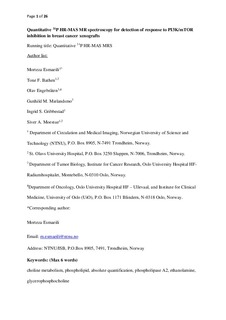Quantitative 31P HR-MAS MR spectroscopy for detection of response to PI3K/mTOR inhibition in breast cancer xenografts
Esmaeili, Morteza; Bathen, Tone Frost; Engebråten, Olav; Mælandsmo, Gunhild; Gribbestad, Ingrid S; Moestue, Siver Andreas
Journal article, Peer reviewed
Accepted version
Permanent lenke
http://hdl.handle.net/11250/2468010Utgivelsesdato
2014Metadata
Vis full innførselSamlinger
Sammendrag
PURPOSE:
Phospholipid metabolites are of importance in cancer studies, and have been suggested as candidate metabolic biomarkers for response to targeted anticancer drugs. The purpose of this study was to develop a phosphorus (31P) high resolution magic angle spinning (HR-MAS) magnetic resonance spectroscopy (MRS) protocol for quantification of phosphorylated metabolites in intact cancer tissue.
METHODS:
31P spectra were acquired on a 14.1 T spectrometer with a triplet 1H/13C/31P MAS probe. Quantification of metabolites was performed using the PULCON principle. Basal-like and luminal-like breast cancer xenografts were treated with the dual PI3K/mTOR inhibitor BEZ235, and the impact of treatment on the concentration of phosphocholine (PCho), glycerophosphocholine (GPC), phosphoethanolamine (PEtn) and glycerophosphoethanolamine (GPE) was evaluated.
RESULTS:
In basal-like xenografts, BEZ235 treatment induced a significant decrease in PEtn (-25.6%, P = 0.01) whilst PCho (16.5%, P = 0.02) and GPC (37.3%, P < 0.001) were significantly increased. The metabolic changes could partially be explained by increased levels of phospholipase A2 group 4A (PLA2G4A).
CONCLUSION:
31P HR-MAS MRS is a useful method for quantitative assessment of metabolic responses to PI3K inhibition. Using the PULCON principle for quantification, the levels of PCho, GPC, PEtn and GPE could be evaluated with high precision and accuracy.
